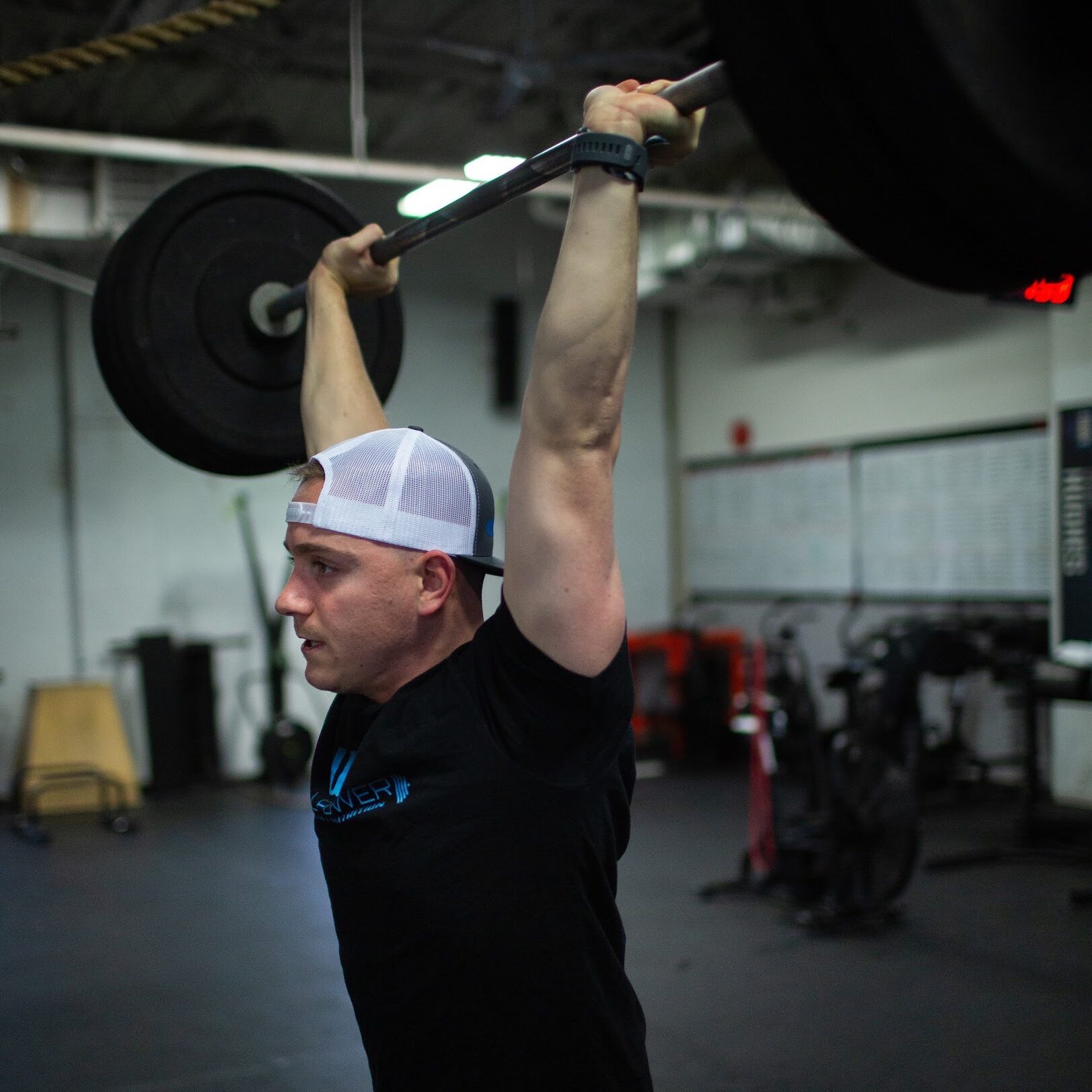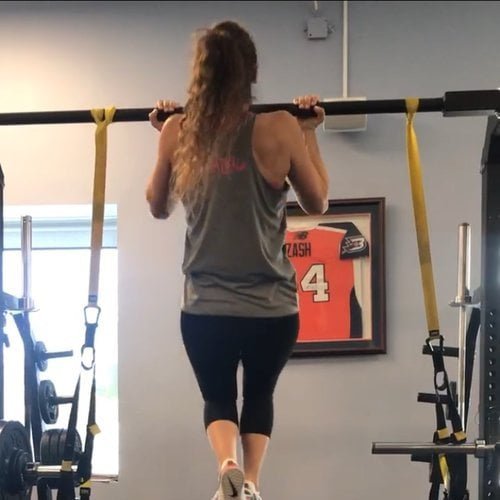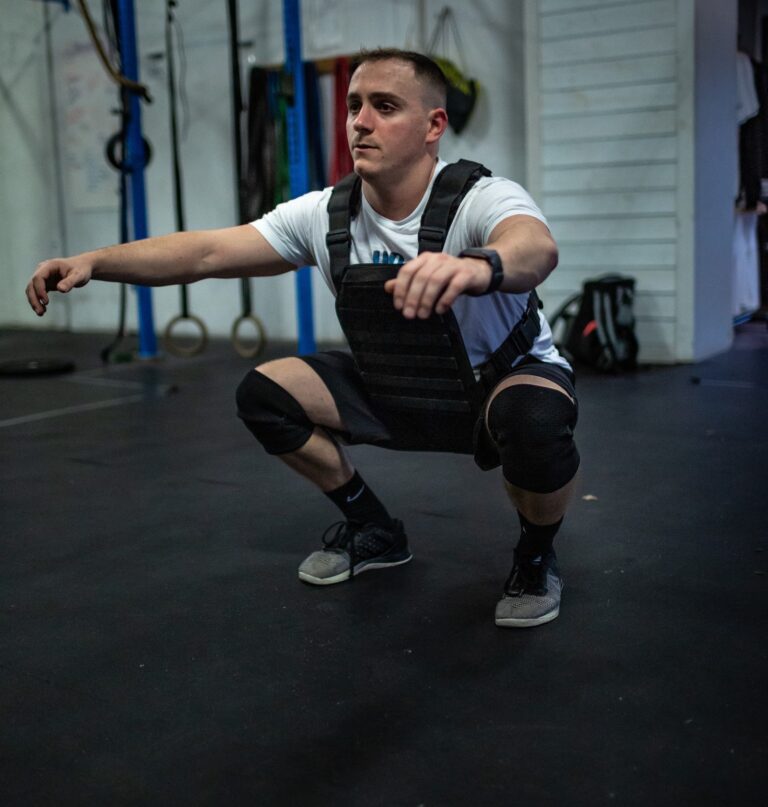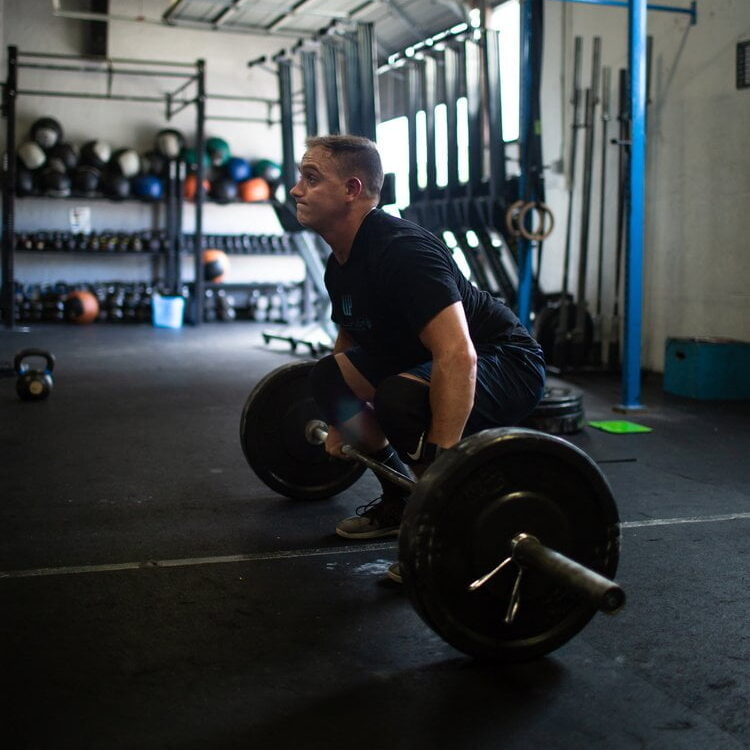Ultimate Guide To The Overhead Shoulder Press In CrossFit
Are you looking to elevate your CrossFit performance and see that your overhead strength needs work? The Overhead Shoulder Press is a foundational exercise inside of the CrossFit methodology. However, mastering this movement demands precision and technique. That’s where this comprehensive guide empowers you to conquer the Overhead Shoulder Press confidently.
Picture this: You’re at your CrossFit box, barbell in hand, looking to set a new Overhead shoulder press personal record. Yet, the struggle to maintain form, the uncertainty about the starting position, and the nagging doubts about your upper body strength might be holding you back. These joint pain points often hinder athletes from perfecting this pivotal exercise.
This guide is your roadmap to success in mastering the Overhead Shoulder Press. From detailed step-by-step instructions to insightful tips, I’m here to assist you in elevating your CrossFit game and building exceptional upper body strength through precise and efficient overhead movements.
In this article, I’ll present the definitive guide to mastering the overhead shoulder press in CrossFit, equipping you with the expertise to conquer this challenging yet rewarding exercise.
How To Perform The Overhead Shoulder Press For CrossFit
This fundamental exercise, involving lifting the bar overhead in a straight line while maintaining proper form, is an essential component of CrossFit workouts. To ensure you’re performing this exercise optimally and avoiding shoulder injuries, here’s a concise yet comprehensive breakdown of the step-by-step process:
- Starting Position:
- Stand with feet shoulder-width apart.
- Grip the bar slightly wider than shoulder-width, elbows slightly in front of the bar.
- Execution:
- Press the bar overhead in a straight line, extending your arms fully.
- Engage your core and ensure your head goes through the ‘window’ formed by your arms.
- Maintain good posture throughout, avoiding excessive arching of the back.
- Return:
- Lower the bar under control to the front rack position.
Benefits of Shoulder Press In CrossFit
There are several benefits of optimizing your shoulder press as a CrossFitter. For starters, it is the methodology’s main upper body strength lift. Although other upper-body compound exercises do show up in CrossFit, such as the bench press, ring dips, and various dumbbell exercises, the shoulder press remains king.
The movement underpins many of the other frequently tested upper body movements and builds the pre-requisite strength for movements like the handstand push-up and wall walks. It has even been tested at the CrossFit games.
Total Upper Body Strength
The shoulder press is a compound exercise for the upper body. It incorporates various shoulder muscles and joints, including the shoulder joint scapulothoracic joint (shoulder blades) and surrounding upper back muscles.
The muscles surrounding the elbow joint, such as the triceps and the core muscles, also get a tremendous amount of work with the shoulder press. They further emphasize how effective exercise is for CrossFit athletes to build their upper body strength at any fitness level.
Front Rack Shoulder Mobility
A good front rack position is required to press optimally with overhead movements. The front rack position involves external rotation, flexion, and abduction of the shoulder joint and flexion and extension of the elbow and wrist, respectively. If an adequate range of motion is present in these joints, it will be easier to press with the correct form and handle heavy weight.
You may see this in CrossFit athletes when they shoulder press, and they cannot get the barbell to the collar bone for the starting position, and the bar essentially floats several inches off of the chest. In developing the shoulder press, the mobility of the shoulders is ideally improved with it to allow for enhanced performance.
Relative Shoulder Strength For Gymnastic Movements
Being able to push heavy weight on the shoulder press is essential in and of itself for CrossFit athletes. But, it’s important to note that isolating and building strength in the overhead pressing motion supports gymnastics movements that also require it like the handstand push-up, wall walks, and handstand walks.
I have conversations with my athletes inside my 1:1 Pain-Free Performance Program frequently around this topic when they request technique drills for these movements. Although developing gymnastic techniques is essential, achieving these skills is ultimately futile. Acquiring these skills is only possible with the necessary absolute strength in the shoulders.
Shoulder Press Tips For CrossFitters
Outside of performing the shoulder press with proper form, as I outlined above, there are some extra things you can focus on to optimize your shoulder press technique and allow you to handle heavier weights instantly. Let’s review some of my top cues for the shoulder press.
Use a shoulder-width grip
Hand placement on the barbell during the shoulder press in CrossFit is an essential factor for a few reasons. First, you will want to ensure that your shoulder press strength gains will translate to movements like the handstand push-up, typically performed with a shoulder width hand placement. So, it would be a great idea to train your shoulder press with the exact distanced grip.
Second, with a shoulder width grip it is easier to create tension in the shoulder joint as you unrack the barbell and assume the starting position. The tension you create will act like a loaded spring to propel the barbell off your upper chest and send the weight overhead. Allowing the upper body to be relaxed and not tense is a common mistake CrossFit athletes make, affecting their performance.
Keep a vertical bar path
Keeping a vertical bar path is arguably the most important tip for the shoulder press in CrossFit. Not only do the overhead gymnastic movements also have a vertical overhead motion, but keeping the barbell moving in a straight line as the arms reach full extension reduces the force the shoulder muscles must produce.
This may bring you back to physics class in high school, but it is an important concept to grasp with the shoulder press and all upper body strength movements. All objects will have a gravitational pull that descends directly down to the ground.
To lift a barbell overhead, you must overcome this downward force with the primary muscles involved with the movement. When the weight deviates from a vertical line, such as when a barbell drifts out in front of the body during the shoulder press, leverage is lost, and the shoulder muscles must produce more force to move the same load.
You can visualize this by feeling the difference in effort needed to lift an object close to you vs. being held away from the body. You can avoid this and move more weight by keeping the weight directly over your center of mass.
Squeeze your glutes
Although the shoulder press is primarily an upper-body CrossFit movement, it utilizes major muscle groups from the entire body. Whenever an athlete of mine is performing the shoulder press, I always cue them to squeeze their glutes to provide a stable base of support for them to press from.
Squeezing the glutes (one of the major lower body muscles) also helps to prevent the rib cage from flaring outward and losing core muscle engagement—another crucial aspect of pressing heavy weight.
Muscles used performing the Shoulder Press
The primary muscles involved in the shoulder press are as follows:
Shoulder joint:
Anterior deltoid
medial deltoid
Rotator cuff muscles
Pectoralis major
Thoracic spine:
Upper trapezius
Elbow joint:
Triceps brachii
Core:
Rectus abdominis
Obliques
Transverse abdominis
Multifidus
Variations & Alternatives To The Shoulder Press
Some folks shouldn’t perform the shoulder press if they aren’t ready. If you cannot complete the overhead motion due to pain or can’t get into a proper front rack position, this may be you. Also, if you fail the Scratch test, this is a good indicator that your shoulder joint mobility needs to be improved before you begin pressing a barbell overhead.
You may also transition away from building absolute strength and use exercises incorporating speed and power into the vertical pressing motion to develop your ability to Olympic lift.
Let’s review some alternatives to the shoulder press movement for CrossFitters.
Push Press
Push presses are a very similar exercise to the shoulder press but differ in that the lower body muscles are utilized to generate momentum to press the barbell off of the chest. When I first learned of push pressing, I viewed the movement as a form of “cheating,” but as I improved as a coach and in my program design, I realized how wrong this was.
The push press is an excellent exercise for learning to connect the legs to the arms for whole-body movement and overloading the shoulders with a weight they may not otherwise have been able to handle. It is also one of the nine foundational movements taught by CrossFit HQ.
Push Jerk
The push jerk seems similar to the push press since it also utilizes the legs to help generate upward lift on the barbell. But the main difference between the push jerk and the shoulder press is that instead of using the legs to drive and press the barbell off of the chest, the legs help propel the barbell off the chest as high as needed to then rapidly descend under the bar to “catch” the barbell in a quarter squat and arms in full extension.
Since the push jerk moves away from pressing and into a catch, you can use the heaviest weight possible of the three overhead movements. It’s a power-building exercise over a strength-biding exercise. So, program these according to your goal for the session.
Bench Press
The bench press is an excellent exercise for developing massive upper body strength but emphasizes different muscle groups. In the bench press, the primary mover of the barbell is the pectoralis major muscles. The shoulders are involved heavily, but less than in the shoulder press.
I will typically program the bench press over the shoulder press if my client needs more overhead mobility or if they lack structural balance concerning horizontal pressing, vertical pressing, or vertical pulling, as in strict pull-ups.
Landmine Press
The landmine press is a favorite of mine to support or substitute the shoulder press exercise. The landmine press is a vertical pressing exercise but not as vertical as the shoulder press since the line of force is closer to a one-hundred-and-twenty-degree angle versus the typical one-hundred-and-eighty-degree angle of the shoulder press.
This is ideal for CrossFit athletes who need to develop their pressing but lack mobility in the shoulder joint or flexibility in the lat muscles on the side of the body to do so with proper form. They also add a component of instability, which is excellent for building stability around the shoulder blades.
Dumbbell Press
The standing dumbbell press is an excellent alternative to the shoulder press because it mimics the movement pattern very well. But it differs because the wrists are in a neutral position, so if barbell pressing causes wrist pain, dumbbells can alleviate this.
Dumbbells also add an element of stability because a barbell does not connect the hands, so they can also provide variety for developing shoulder strength and improving shoulder blade stability.
FAQ
What Is A Shoulder Press CrossFit WOD?
The world is your oyster when deciding on a good CrossFit WOD (workout of the day), but below are a few examples for you.
Strength
For total load:
Deadlift
Shoulder Press
Back Squat
Metabolic Conditioning
AMRAP in 5 minutes
10 Shoulder Presses (75/55 lb)
15 Kettlebell Swings (24/20 kg)
Are Shoulder Presses Safe?
Yes! Like any foundational movement, the shoulder press is very safe when you use the correct form, load, and progression. The key to maximizing safety in an exercise is to start with an assessment to see how you are moving and then select exercises that are right for you if the shoulder press causes pain or your technique needs work.
Once you can do the movement with great form, start slowly and add weight over time as long as the movement looks good. Lastly, progress the movement with proper exercise selection and variation, such as with various grips or resistance bands.
Why Is Shoulder Press So Difficult?
There is no way around it: shoulder presses are a challenging exercise! But that is what makes it so rewarding to keep training. The shoulder press isolates the shoulders and doesn’t allow you to use your legs, making increasing weights week to week challenging. With the information you now have after reading this article, you will be primed and ready to optimize your movement and set a new personal record in no time.
The Wrap-Up On Shoulder Press In CrossFit
You have everything you need to crush your shoulder presses in your next CrossFit WOD. Use this article as a guide to reference when they come up in your training, and you want to set yourself up for a new personal best. Remember that building strength is a long-term play, and patience is vital if you hope to keep improvements going for years to come and keep your shoulders pain-free.
If you need help improving your shoulder health or dialing in your training program to increase your shoulder press strength, I would love to chat about how I can help you. Please click HERE to schedule your risk-free consultation!







